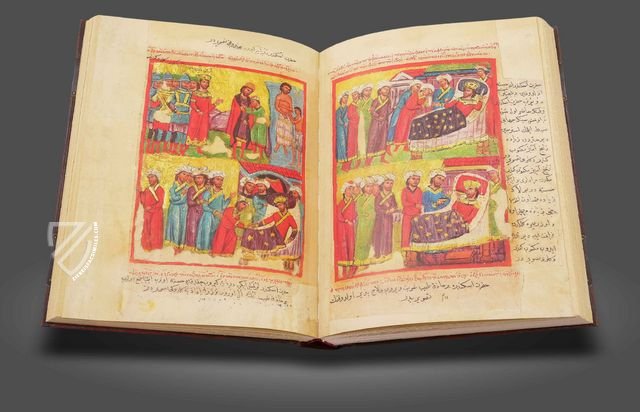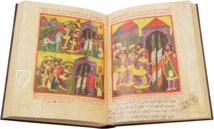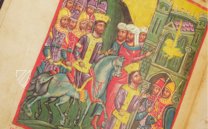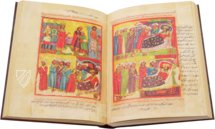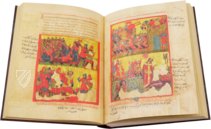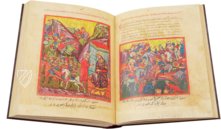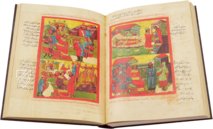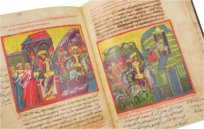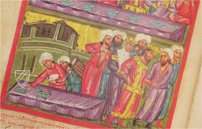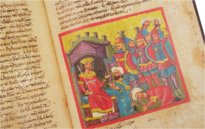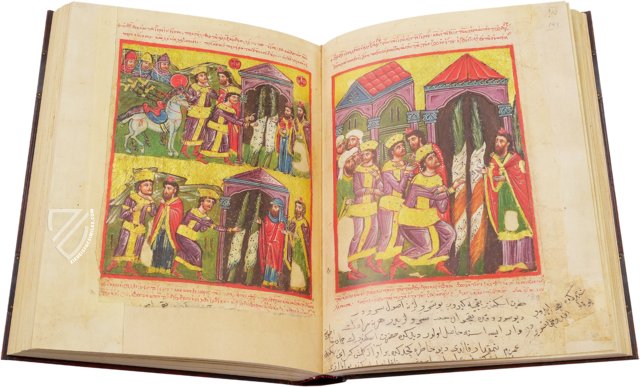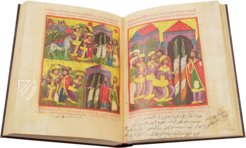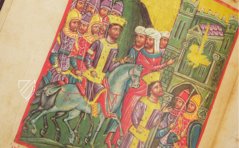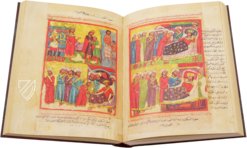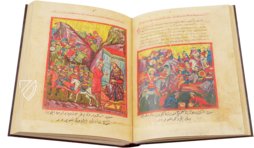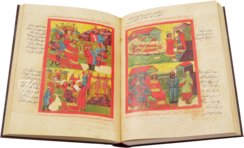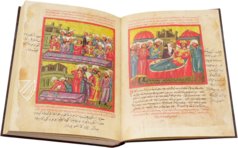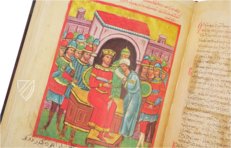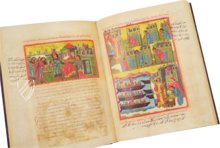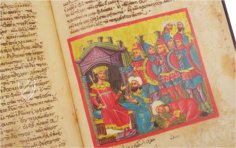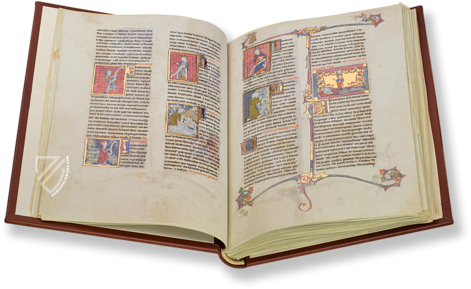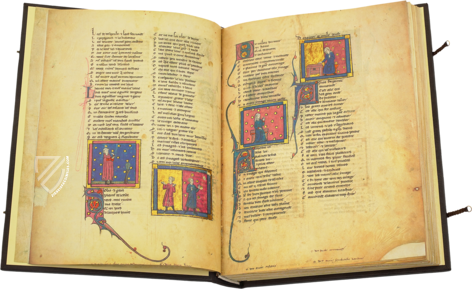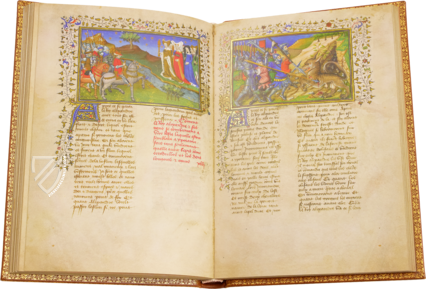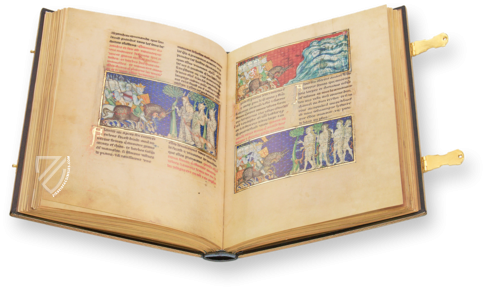Trebizond Alexander Romance
(under 1,000€)
The Trebizond Alexander Romance is one of the most luxurious and best-preserved secular Byzantine manuscripts. It was commissioned by Emperor Alexios III in the second half of the 14th century at the imperial court of Trebizond and was intended not only to present the legendary story of Alexander the Great in an ornate setting. Rather, the opulent picture program also shows a deliberate staging of Alexios III as the successor and 'heir' of the ancient king, who functioned as an ideal for many medieval rulers. Although the manuscript bears clear traces of its eventful ownership history, it has lost hardly any of its former splendor and still radiates the intended courtly claim to power.
A Literary Classic
The so-called Alexander romance contains the pseudo-historical legend of the biography of the Macedonian king Alexander the Great (356–323 BC). It tells mainly about his countless battles and military successes in the expansion of his dominion. Especially in the Middle Ages, the text enjoyed great popularity and its wide dissemination and the many translations contributed to the emergence of different versions of the story over time – Many of them 'Christianized' the ancient text and made Alexander an ideal and model of Christian rulers.
The Greek copy from the Istituto Ellenico holds a particularly detailed version of the tradition-rich text and was probably produced by an unknown scribe in the second half of the 14th century at the imperial court of Trebizond for Emperor Alexios III (1338–1390).
Fine Art for Political Propaganda
The Empire of Trebizond, with its eponymous 'capital', was a successor state of the Byzantine Empire founded after the conquest of Constantinople in the Fourth Crusade in 1204. It comprised what is now known as Pontos and was formerly Byzantine territory on the southern coast of the Black Sea. Alexios III's 41-year reign began when he usurped the throne of the small empire in 1349. He took over an empire that was in a state of civil war, which he then sought to pacify by any means necessary. His goal was to recapture the glory of the early days of the empire and regain political prestige in the region in order to assert himself against Constantinople.
These efforts are also evident in the magnificent Alexander romance: in its picture program, Alexios III appears as the successor and 'heir' of Alexander the Great, whose story is actually told in the manuscript. Thus, a continuity between Alexander's powerful Empire of antiquity and the Empire of Trebizond is depicted, which should additionally legitimize Alexios' claim to power. This becomes particularly clear, on the one hand, in the depictions of the ancient ruler in Byzantine imperial garb, i.e. as a Byzantine emperor, but also in the opposing images of Alexander and Alexios on the first pages of the manuscript. Thus, there was once a portrait of the first at the beginning of the codex, which was followed by the still preserved, but badly damaged, frontal representation of Alexios III. – today fol. 1r.
Legendary images in imperial garb
The propagandistic details are found in almost all 250 large-scale miniatures, which were placed by three unknown illuminators on only 386 pages. The expressive and multi-figured images can be read almost like a comic novel and provide the reader with a colorful insight into the almost mythical life of Alexander the Great. His birth, his legendary fights with terrible monsters, the numerous battles, his weddings as well as his death are particularly focused on. The scenes are decribed by captions in red display script, which was also used for title lines and initials.
The dominant miniatures usually take up about half a page, but were also frequently executed on a full page and are then usually divided into two registers. The dynamic, polychrome sceneries unfold in striking red frames. Particularly striking is the exuberant use of gold leaf, which was employed not only for any backgrounds, but also for countless details in the robes of the figures. This sumptuous decoration also radiates courtly power and political legitimacy of rule.
Testimony to an eventful history
The old splendor still dwells in the manuscript today, although it bears clear traces of its changing ownership history. In the course of time, not only was the binding and thus the order of the folios changed, but some were also lost. And the surviving leaves are corroded - partly due to the pigments used - and the ink has faded in many places. On the other hand, the valuable manuscript also received some additions: After Trebizond was conquered by the Ottoman Empire in 1461, it passed into the hands of Ottoman owners, who added Turkish inscriptions in black ink to the miniatures. After that, the manuscript reappears in the sources only at the beginning of the 19th century, in Venice, where it was possibly brought by Konstantinos Maroutses (Maruzzi), in whose possession it was until shortly after his death in 1846. Thirty years later it was in the Archbishop's Library of San Giorgio dei Greci, and in 1879 it was part of the possessions of the Greek Brotherhood of Venice. Eventually, in 1953, it was transferred to the newly established Istituto Ellenico in Venice.
Codicology
- Alternative Titles
- Codex 5 (The Venice Alexander Romance)
Alexanderroman aus Trapezunt
Venice Alexander Romance
Codex Greacus 5 - Type
- Manuscript on paper
- Size / Format
- 386 pages / 32.0 × 24.0 cm
- Origin
- Turkey
- Date
- Second half of the 14th century
- Epochs
- Style
- Genre
- Script
- Greek Minuscule Naskh script
- Illustrations
- 250 miniatures, many of them full-page, and a magnificently decorated heading
- Content
- Romance of Alexander
- Patron
- Emperor Alexios III Megas Komnenos of Trebizond (1338–1390)
- Artist / School
- Pseudo-Callisthenes (author)
- Previous Owners
- Konstantinos Maroutses
San Giorgio dei Greci
Confraternita greca di Venezia
Trebizond Alexander Romance
Alexander and Bukephalos
Alexander's legendary horse Bucephalus, which means 'ox-headed', is probably one of the most famous animals in history. Bought by Alexander's father Philip II, it could not be tamed by anyone. Just the 12-year-old Alexander realized that the horse was afraid of its shadow and was finally able to ride it. As a result, Bucephalus accompanied him in all his battles. Accordingly, the military commander is also frequently depicted on his steed in the Trebizond Alexander Romance.
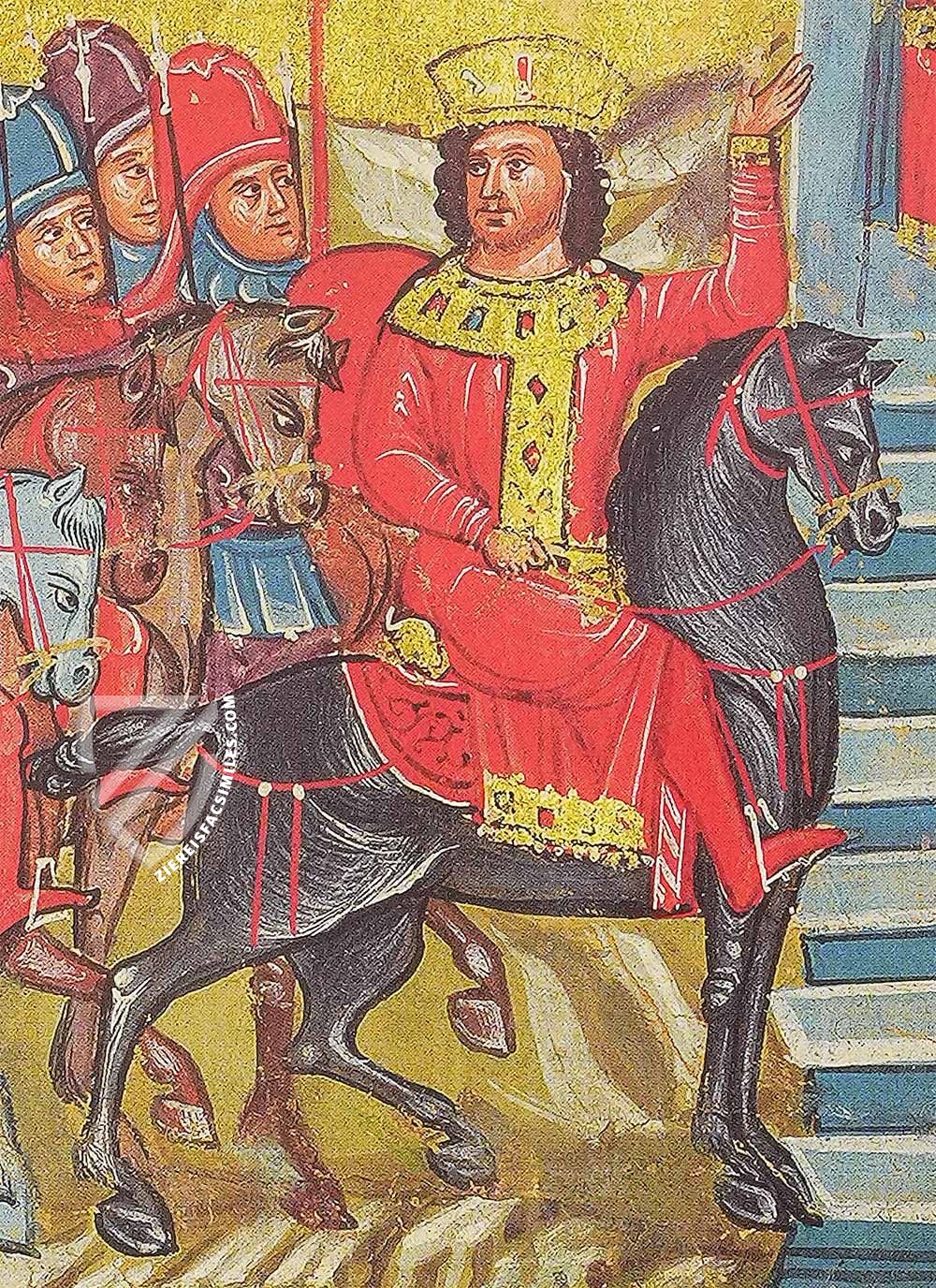
Trebizond Alexander Romance
Alexander sends out heralds
After his first victorious battle with 15, the cocky Alexander in the upper register sends messengers to all possible lands to announce his demand: the subservience of the other kingdoms. After receiving the document to be delivered from Alexander, the two couriers in the flamboyant triangular red hats with round pom-poms set off in the upper right, not seeming particularly convinced of their mission.
The lower register shows that their concerns were justified: They were hanged. Alexander's demands especially enraged the Tyrians, who under no circumstances wanted to subject their city to a still insignificant youngster. Alexander probably reads this answer in the document unrolled in front of him.
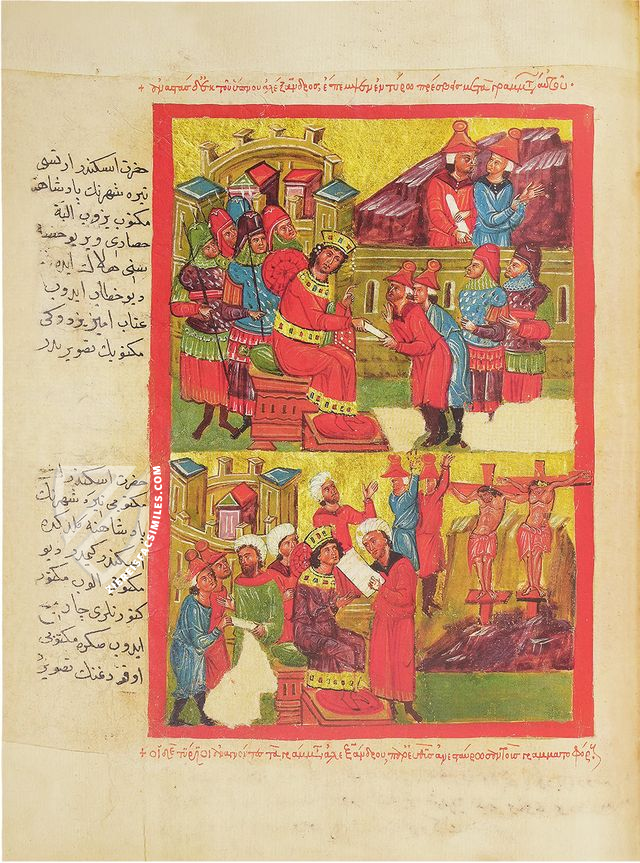
#1 Codex 5 (The Venice Alexander Romance)
Language: English, Greek
(under 1,000€)
- Treatises / Secular Books
- Apocalypses / Beatus
- Astronomy / Astrology
- Bestiaries
- Bibles / Gospels
- Chronicles / History / Law
- Geography / Maps
- Saints' Lives
- Islam / Oriental
- Judaism / Hebrew
- Single Leaf Collections
- Leonardo da Vinci
- Literature / Poetry
- Liturgical Manuscripts
- Medicine / Botany / Alchemy
- Music
- Mythology / Prophecies
- Psalters
- Other Religious Books
- Games / Hunting
- Private Devotion Books
- Other Genres
- Afghanistan
- Armenia
- Austria
- Belgium
- Colombia
- Croatia
- Cyprus
- Czech Republic
- Denmark
- Egypt
- Ethiopia
- France
- Germany
- Greece
- Hungary
- India
- Iran
- Iraq
- Israel
- Italy
- Japan
- Lebanon
- Luxembourg
- Mexico
- Morocco
- Netherlands
- Palestine
- Peru
- Poland
- Portugal
- Russia
- Serbia
- Spain
- Sri Lanka
- Sweden
- Switzerland
- Syria
- Turkey
- Ukraine
- United Kingdom
- United States
- Uzbekistan
- Aboca Museum
- Ajuntament de Valencia
- Akademie Verlag
- Akademische Druck- u. Verlagsanstalt (ADEVA)
- Aldo Ausilio Editore - Bottega d’Erasmo
- Alecto Historical Editions
- Alkuin Verlag
- Almqvist & Wiksell
- Amilcare Pizzi
- Andreas & Andreas Verlagsbuchhandlung
- Archa 90
- Archiv Verlag
- Archivi Edizioni
- Arnold Verlag
- ARS
- Ars Magna
- ArtCodex
- AyN Ediciones
- Azimuth Editions
- Badenia Verlag
- Bärenreiter-Verlag
- Belser Verlag
- Belser Verlag / WK Wertkontor
- Benziger Verlag
- Bernardinum Wydawnictwo
- BiblioGemma
- Biblioteca Apostolica Vaticana (Vaticanstadt, Vaticanstadt)
- Bibliotheca Palatina Faksimile Verlag
- Bibliotheca Rara
- Boydell & Brewer
- Bramante Edizioni
- Bredius Genootschap
- Brepols Publishers
- British Library
- C. Weckesser
- Caixa Catalunya
- Canesi
- CAPSA, Ars Scriptoria
- Caratzas Brothers, Publishers
- Carus Verlag
- Casamassima Libri
- Chavane Verlag
- Christian Brandstätter Verlag
- Circulo Cientifico
- Club Bibliófilo Versol
- Club du Livre
- CM Editores
- Collegium Graphicum
- Collezione Apocrifa Da Vinci
- Comissão Nacional para as Comemorações dos Descobrimentos Portugueses
- Coron Verlag
- Corvina
- CTHS
- D. S. Brewer
- Damon
- De Agostini/UTET
- De Nederlandsche Boekhandel
- De Schutter
- Deuschle & Stemmle
- Deutscher Verlag für Kunstwissenschaft
- DIAMM
- Droz
- E. Schreiber Graphische Kunstanstalten
- Ediciones Boreal
- Ediciones Grial
- Ediclube
- Edições Inapa
- Edilan
- Editalia
- Edition Deuschle
- Edition Georg Popp
- Edition Leipzig
- Edition Libri Illustri
- Editiones Reales Sitios S. L.
- Éditions de l'Oiseau Lyre
- Editions Medicina Rara
- Editorial Casariego
- Editorial Mintzoa
- Editrice Antenore
- Editrice Velar
- Edizioni Edison
- Egeria, S.L.
- Eikon Editores
- Electa
- Emery Walker Limited
- Enciclopèdia Catalana
- Eos-Verlag
- Ephesus Publishing
- Ernst Battenberg
- Eugrammia Press
- Extraordinary Editions
- Fackelverlag
- Facsimila Art & Edition
- Facsimile Editions Ltd.
- Facsimilia Art & Edition Ebert KG
- Faksimile Verlag
- Feuermann Verlag
- Folger Shakespeare Library
- Franco Cosimo Panini Editore
- Friedrich Wittig Verlag
- Fundación Hullera Vasco-Leonesa
- G. Braziller
- Gabriele Mazzotta Editore
- Gebr. Mann Verlag
- Gesellschaft für graphische Industrie
- Getty Research Institute
- Giovanni Domenico de Rossi
- Giunti Editore
- Graffiti
- Grafica European Center of Fine Arts
- Guido Pressler
- Guillermo Blazquez
- Gustav Kiepenheuer
- H. N. Abrams
- Harrassowitz
- Helikon
- Hendrickson Publishers
- Henning Oppermann
- Herder Verlag
- Hes & De Graaf Publishers
- Hoepli
- Holbein-Verlag
- Hortus Deliciarum
- Houghton Library
- Hugo Schmidt Verlag
- Idion Verlag
- Il Bulino, edizioni d'arte
- ILte
- Imago
- Insel Verlag
- Instituto Nacional de Antropología e Historia
- Istituto dell'Enciclopedia Italiana - Treccani
- Istituto Ellenico di Studi Bizantini e Postbizantini
- Istituto Geografico De Agostini
- Istituto Poligrafico e Zecca dello Stato
- Italarte Art Establishments
- J. Thorbecke
- Jan Thorbecke Verlag
- Johnson Reprint Corporation
- Josef Stocker
- Josef Stocker-Schmid
- Jugoslavija
- Karl W. Hiersemann
- Kasper Straube
- Kaydeda Ediciones
- Kindler Verlag / Coron Verlag
- Kodansha International Ltd.
- Konrad Kölbl Verlag
- Kurt Wolff Verlag
- La Liberia dello Stato
- La Linea Editrice
- La Meta Editore
- Lambert Schneider
- Landeskreditbank Baden-Württemberg
- Leo S. Olschki
- Les Incunables
- Library of Congress
- Libreria Musicale Italiana
- Lichtdruck
- Lito Immagine Editore
- Lumen Artis
- Lund Humphries
- M. Moleiro Editor
- Maison des Sciences de l'homme et de la société de Poitiers
- Manuscriptum
- Martinus Nijhoff
- Maruzen-Yushodo Co. Ltd.
- MASA
- McGraw-Hill
- Militos
- Millennium Liber
- Müller & Schindler
- Nahar and Steimatzky
- National Library of Wales
- Neri Pozza
- Nova Charta
- Oceanum Verlag
- Odeon
- Orbis Mediaevalis
- Orbis Pictus
- Österreichische Staatsdruckerei
- Oxford University Press
- Pageant Books
- Parzellers Buchverlag
- Patrimonio Ediciones
- Pattloch Verlag
- PIAF
- Pieper Verlag
- Plon-Nourrit et cie
- Prestel Verlag
- Princeton University Press
- Prisma Verlag
- Priuli & Verlucca, editori
- Pro Sport Verlag
- Propyläen Verlag
- Pytheas Books
- Quaternio Verlag Luzern
- Reales Sitios
- Recht-Verlag
- Reichert Verlag
- Reichsdruckerei
- Riehn & Reusch
- Roberto Vattori Editore
- Rosenkilde and Bagger
- Roxburghe Club
- Salerno Editrice
- Sarajevo Svjetlost
- Schöck ArtPrint Kft.
- Scolar Press
- Scrinium
- Scripta Maneant
- Scriptorium
- Siloé, arte y bibliofilia
- SISMEL - Edizioni del Galluzzo
- Sociedad Mexicana de Antropología
- Société des Bibliophiles & Iconophiles de Belgique
- Soncin Publishing
- Sorli Ediciones
- Stainer and Bell
- Studer
- Styria Verlag
- Sumptibus Pragopress
- Szegedi Tudomànyegyetem
- Taberna Libraria
- Tarshish Books
- Taschen
- Tempus Libri
- Testimonio Compañía Editorial
- Thames and Hudson
- The Clear Vue Publishing Partnership Limited
- The Facsimile Codex
- The Folio Society
- The Marquess of Normanby
- The Richard III and Yorkist History Trust
- Tip.Le.Co
- TouchArt
- TREC Publishing House
- TRI Publishing Co.
- Trident Editore
- Typis Regiae Officinae Polygraphicae
- Union Verlag Berlin
- Universidad de Granada
- University of California Press
- University of Chicago Press
- Urs Graf
- Vallecchi
- Van Wijnen
- VCH, Acta Humaniora
- VDI Verlag
- VEB Deutscher Verlag für Musik
- Verlag Anton Pustet / Andreas Verlag
- Verlag Bibliophile Drucke Josef Stocker
- Verlag der Münchner Drucke
- Verlag für Regionalgeschichte
- Verlag Styria
- Vicent Garcia Editores
- W. Turnowsky
- Waanders Printers
- Wiener Mechitharisten-Congregation (Wien, Österreich)
- Wissenschaftliche Buchgesellschaft
- Wydawnictwo Dolnoslaskie
- Xuntanza Editorial
- Zakład Narodowy
- Zollikofer AG

